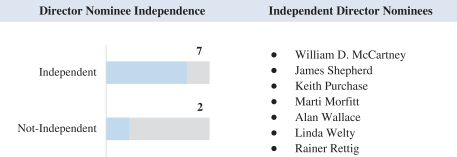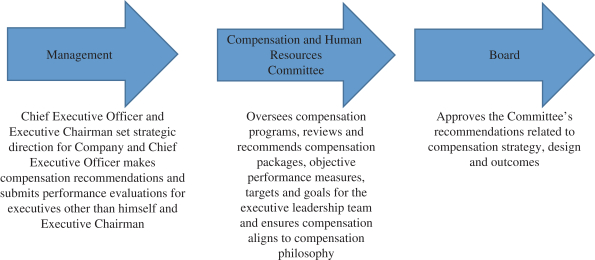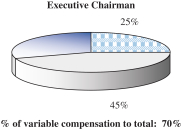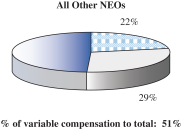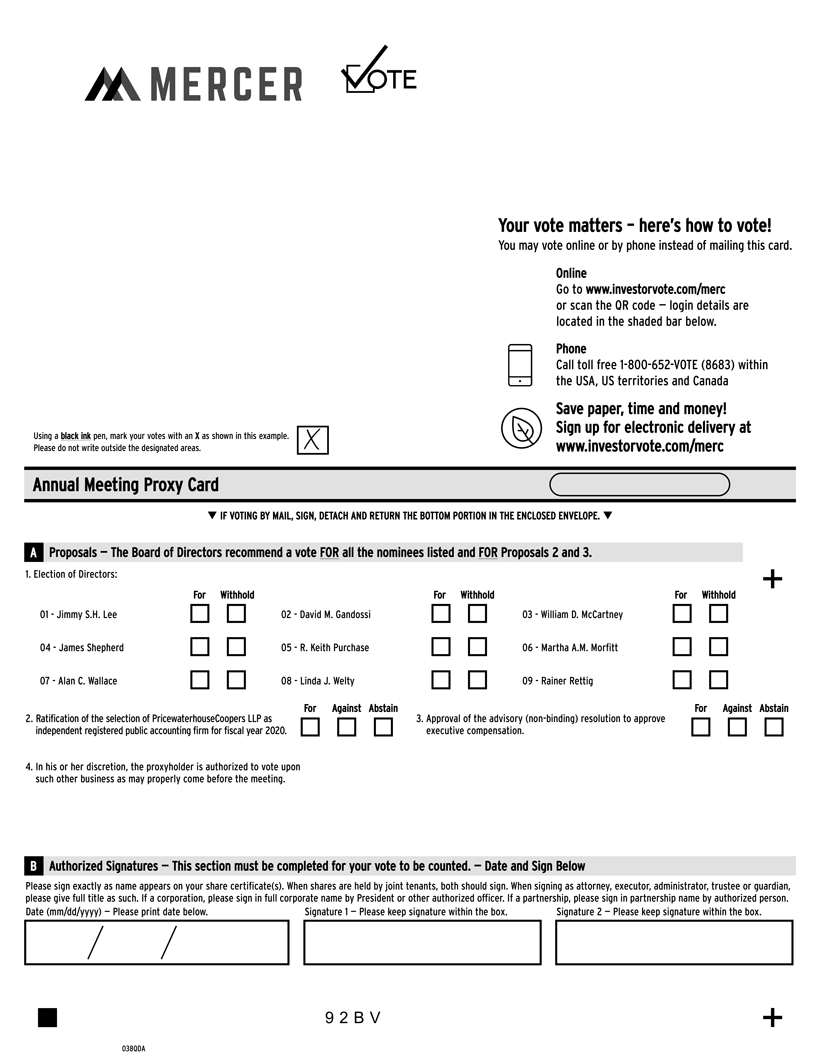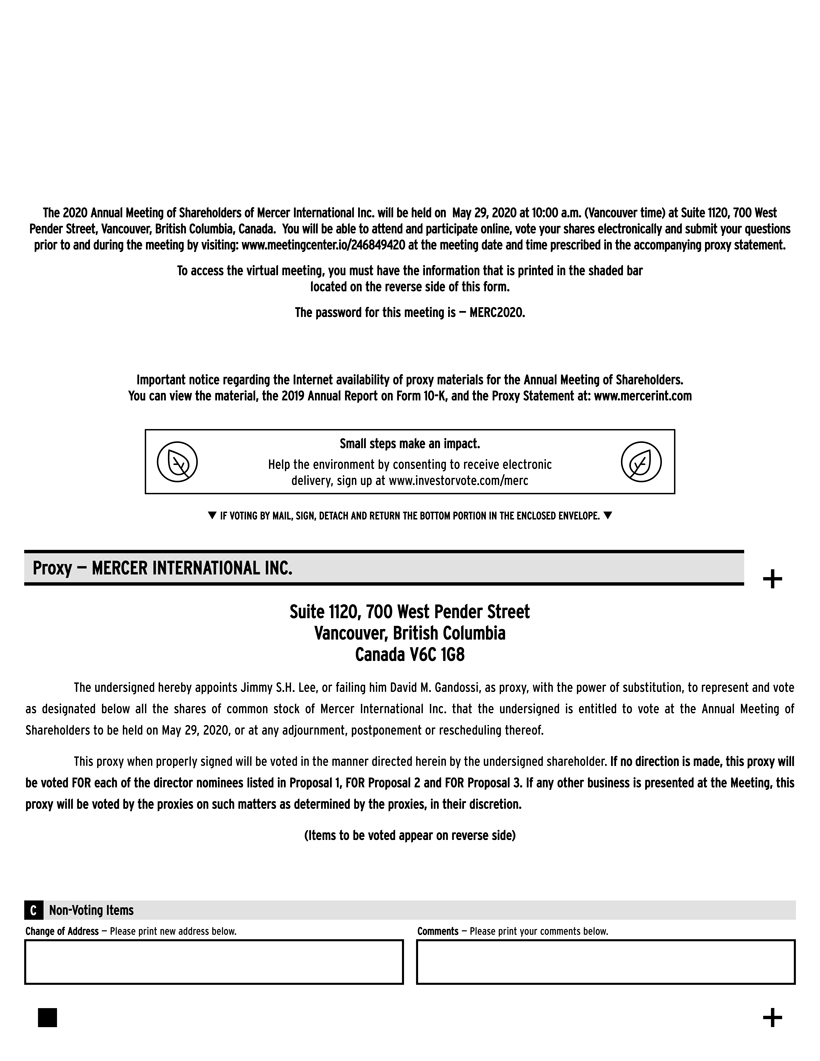Environmental, Health and Safety Committee: Oversees our environmental, health and safety policies and environmental compliance programs and associated risks relating thereto. In connection with such oversight, the committee regularly visits and tours our mills and meets with mill-level managers, superintendents and other employees.
Governance and Nominating Committee: Oversees our governance practices, director succession and committee leadership to manage risks associated with corporate governance.
The full Board regularly evaluates and discusses risk, risk mitigation strategies and our internal control environment. Topics examined at these meetings include, but are not limited to, financial risks, risks related to the global COVID‑19 pandemic, environmental risks, governance risks, political and regulatory risks, legal risks, information technology risks, economic risks, risks relating to growth strategies, social licence and stakeholder risks and risks related to our productivity and reinvestment efforts. In 2022, the Board actively and regularly reviewed, monitored and assessed our responses, including our health and safety protocols, to address the risks posed by the COVID‑19 pandemic, including virtually attending senior management planning sessions and receiving written updates from our executives. Because overseeing risk is an ongoing process and inherent in our strategic decisions, the Board also discusses risk throughout the year.
We believe that our Board leadership structure, previously discussed herein, supports the risk oversight function of the Board. We have an Executive Chairman, a Chief Executive Officer, a Lead Director and strong directors chairing the various committees involved with risk oversight. There is open communication between management and directors and all directors are actively involved in the risk oversight function.
To learn more about risks facing us, you can review the factors included in Part 1, Item 1A. “Risk Factors”"Risk Factors" in the Form10-K. The risks described in the Form10-K are not the only risks facing the Company.we face. Additional risks and uncertainties not currently known or that may currently be deemed to be immaterial also may materially adversely affect the Company’sour business, financial condition or results of operations in future periods.
During fiscal 2019,2022, risk areas of particular Board and committee focus included:
•
industry supply and demand balances and the outlook for the global economy including commodities;
•cyclical fluctuations in the supply and potential changesprice of raw materials including fiber;
•volatility and economic disruptions particularly in fiber supply;Europe resulting from the Russian invasion of Ukraine including prices and availability of energy and governmental initiatives and responses thereto;
•
the macro-economic effect of the war in Ukraine including economic and other sanctions and trade restrictions imposed by governments;
•the effects of inflation or a sustained increase in our production costs and the macro-economic effects of rising interest rates;
•expansion and growth of our solid wood business in the forest products and related or ancillary businesses;
financial risksbusinesses including balance sheet strength through an industry downturn;
the acquisition of the Torgau facility; cybersecurity;
•our continuing succession planning including the transition to a new Chief Financial Officer in 2023;
•
our sustainability initiatives including ESG matters;matters and our approach to climate change;
•
the uncertaineffects of the global economic environment, including potential issues regarding international trade, including tariffs, and its effectsCOVID-19 pandemic on our business;business, operations and workforce and implementing effective health and safety protocols in response to the pandemic to protect our workforce and to keep our mills operating safely and efficiently;
26
•Shareholder distributions.
Data Privacy and Cybersecurity Risk Oversight
We maintain comprehensive programs and technologies to ensure that our information systems are effective and prepared for data privacy and cybersecurity risks, including regular oversight of our security programs for monitoring internal and external threats to ensure the confidentiality and privacy of our data. As the volume and complexity of cyber-attacks continue to increase, we continue to enhance our security capabilities by continued investment in cyber technologies, building awareness and educating our workforce regarding cyber-security, and leveraging emerging technologies.
We regularly perform evaluations of our security program and continue to implement controls aligned with industry guidelines to identify threats, detect attacks and protect data. We have aligned our cybersecurity program with ISO 27001. We periodically undertake cybersecurity audits and internal and external penetration testing performed by a third party, the results of which are reported to the Audit Committee.
We have also implemented security monitoring programs designed to alert us of any suspicious activity, and have developed an incident response program in the event of a security breach.
The Audit Committee, pursuant to its charter, is tasked with oversight of our cyber security and information governance, including periodically reviewing and discussing with management our risk exposures relating to data privacy and cyber-security, and reviewing the steps we have taken to identify, assess, monitor, mitigate and manage such exposure and cybersecurity risks. The Audit Committee and management regularly meets with the Board to provide regular updates on cybersecurity risks, material cyber-attacks and security incidents as they occur, as well as to promote company-wide cyber risk and security awareness. Additionally, our Director of Information Technology and Cybersecurity meets at least twice annually with the Board or the Audit Committee to brief them on technology and information security matters.Day-to-day management of security is currently the responsibility of our Vice President, Controller.
We carry insurance that provides protection against the potential losses arising from a cybersecurity incident. In the last three years, we have not experienced a material information security breach, and accordingly, have not incurred any net expenses from information security breaches or information security breach penalties and settlements over the last three years relative to total revenue.
Corporate Social Responsibility
We have a longstanding commitment to corporate social responsibility and take a disciplined approach to developing ESG strategies and programs to support ESG causes and initiatives. In recent years, we have increased our focus on ESG with the goal of creating long-term, sustainable value for our stakeholders.
In 2022, we focused on advancing the following ESG strategic priorities: climate change, diversity, equity and inclusion, and talent development and education.
Please see our Annual Report on Form 10-K for 2022 for a detailed description of our commitment and focus on such strategic priorities and how we have advanced our ESG initiatives, which in 2022 included the following selected highlights:
Sustainability
We believe that focusing on sustainability as a key driver in all of our operations and business will enhance our decision-making, our business and our relationships with our various stakeholders and communities in which we operate. We believe all of the foregoing elements are inter-connected and are vital to our long-term future, success and sustainability.
As part of our commitment and focus on sustainability, in 2022, we have, among other things:
Shareholder distributions;•
conducted our second climate change scenario analysis to evaluate the risks and opportunities of climate change as part of our adoption of the Task Force on Climate-related Financial Disclosure recommendations;
27
•conducted a biodiversity workshop with our global team to understand how we impact and depend on nature and our management practices to manage these biodiversity risks as part of our commitment to report using the Task Force on Nature-related Financial Disclosure recommendations;
•entered into the New German Facility which is sustainability linked whereby the interest rate margin is subject to upward or downward adjustments of up to 0.05% per annum based upon meeting certain specified sustainability targets; and
•published our inaugural Sustainability Report, which we plan to update for 2023.
Diversity, Equity and Inclusion/ Social Responsibility
We are committed to diversity and inclusion, within our own operations, for our employees, with suppliers and in the communities we serve. In 2022, we:
•
continued to effect changes to our continuingrecruiting and training processes to make our workplaces more reflective of the diversity that exists in our communities; and
•continued to pursue positive and respectful working relationships with various stakeholders and communities, including working closely and partnering with regional First Nations groups in Canada to foster mutually beneficial economic activities and beneficial relationships.
Talent Development and Education
We believe the strength of our workforce is one of the significant contributors to our success as a global company and we recognize the positive impact that our employees make at our Company and for our clients and communities that we serve. All our employees contribute to our success and help us drive strong financial performance. Accordingly, attracting, developing and retaining global talent through learning and growth opportunities and creating a diverse and inclusive culture is central to our purpose, mission and long-term growth strategy.
Specifically, we promote employee development by reviewing strategic positions regularly and identifying potential internal candidates to fill those roles, evaluating job skill sets to identify competency gaps and creating developmental plans to facilitate employee professional growth. We invest in our employees through training and development programs, on the job experiences and coaching. We provide technical and leadership programs across the organization that enable colleagues to grow skills and capabilities to become more successful.
For further information about our investment in our people and related initiatives, see our Annual Report on Form 10-K for 2022 under "Human Capital".
Health and Safety
Safety is a core value of ours. The industries in which we operate have their own particular set of risks including hazards from our complex industrial manufacturing facilities such as manufacturing processes, mobile equipment, heavy and complex equipment, high pressure boilers, energy production, and the use and recovery of chemicals. Accordingly, we have created our "Road to Zero" health and safety program, which is a company-wide initiative designed to create healthy, safe and productive work environments with a goal of zero workplace incidents.
We have developed tools to analyze potential and incurred incidents and we have resources to develop prevention initiatives. Our priority is the elimination of hazards, followed by safe administrative practices and appropriate personal protective equipment. We identify, monitor, educate, and take a data-driven approach to drive workplace safety improvements. Many of our programs revolve around education, hazard identification, and risk mitigation strategies. These proactive initiatives bring safety to the forefront of our work practices.
ESG Oversight
Our Board is engaged in providing oversight, advice and assistance to our management in developing, implementing and monitoring environmental, social and governance policies, practices and strategies that will help foster our sustainability goals in view of our strategic direction. This includes oversight of our approaches to managing climate-related impacts.
We manage and operate our business, including the natural resources under our care or direction, with a long-term view and focus on sustainability. We believe by doing so we will be able to deliver value to our customers, employees,
28
shareholders, communities and other stakeholders. We strive to maintain the highest environmental, social and governance standards. We believe that by caring for the health and safety of our workers, maintaining the environmental quality of our operations and being part of and actively engaged in the communities in which we operate, we enhance the value for all of our various stakeholders and our social licence to operate.
Our Board delegates some of the oversight to the various committees, including the Environmental, Health and Safety Committee, the Audit Committee and the Governance and Nominating Committee. The Environmental, Health and Safety Committee is tasked with the responsibility of overseeing the effectiveness of our sustainability practices, and reviewing, on an annual basis, our environmental priorities and ensuring that we grow in a manner consistent with our long-term sustainability objectives and strategic plan. The Audit Committee is primarily tasked with reviewing the financial aspects of our sustainability initiatives. Our Governance and Nominating Committee is tasked with overseeing our governance practices and policies. Finally, our Human Resources Committee is responsible for overseeing the development and implementation of human capital development plans and succession planning.planning practices to foster sufficient management depth to support our continued growth and the talent needed to execute long-term strategies.






















































































































